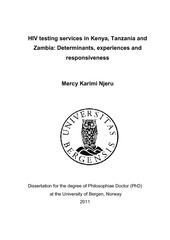| dc.contributor.author | Njeru, Mercy Karimi | en_US |
| dc.date.accessioned | 2011-07-15T07:52:23Z | |
| dc.date.available | 2011-07-15T07:52:23Z | |
| dc.date.issued | 2011-06-17 | eng |
| dc.identifier.isbn | 978-82-308-1785-8 (print version) | en_US |
| dc.identifier.uri | https://hdl.handle.net/1956/4837 | |
| dc.description.abstract | Introduction: HIV/AIDS has been one of the most challenging pandemics in health and development. Sub- Saharan Africa remains the most affected region and it handles over two-thirds of the individuals infected world wide. A large number of interventions have been implemented to control the infection. HIV testing is one of these interventions, and is a key entry point for both prevention and treatment. HIV testing has mainly been offered through the client initiated, voluntary counselling and testing (VCT) services. However, low use of VCT has been reported in several studies despite substantial scale-up during the past 10-15 years. Provider-initiated testing and counselling (PITC) models have been introduced to increase the test rates in the context of the growing availability of treatment. Nevertheless, little has been documented on experiences with the PITC model. This study sought to assess exposure to HIV testing through VCT and the prevention of mother to child transmission (PMTCT) based testing services that practice PITC at antenatal clinics, investigate determinants of VCT use, explore experiences and perceptions with the PITC model within PMTCT program and assess the applicability of the responsiveness concept in the evaluation of VCT. Methods: The thesis comprises of: 1) a cross-sectional study of 5689 respondents in three African districts; 2) a concurrent triangulation mixed-methods study that utilised data from: a population-based survey in three study districts, 34 focus group discussions and 18 in-depth interviews; and 3) a concurrent nested mixed-methods study applied in one of the study districts among 328 VCT users and 36 VCT counsellors. Results: The findings indicate that education attainment and stigma were significantly associated with VCT use across the three districts. Women were much more likely to test for HIV than men in the two districts with seemingly higher use of PMTCT. Only minor gender differences appeared for VCT use. PMTCT-based HIV testing was not always accompanied by pre-test counselling and limited post-test counselling was experienced. In settings where the PITC model had been scaled up extensively through the PMTCT program, informants expressed frustration related to their experienced inability to ‘opt-out’ or decline from the providerinitiated HIV testing services. There was an experienced additional burden on women testing through the PMTCT program as they were encouraged to recruit their spouses to go for HIV testing. The elements proposed by WHO to measure responsiveness were highly valued in a VCT context. However, qualitative findings revealed pertinent aspects of the elements (e.g. confidentiality and autonomy) that were experienced as crucial in the local setting, but had not been captured by the tool. Conclusion: Variations in HIV testing exposure was largely related to the extent to which the PITC model had been scaled up through the PMTCT program in the three districts. Determinants of VCT use differed less by district. Education attainment and HIV stigma were dominant factors related to HIV testing across the three districts. This underscores the need to improve efforts to promote education and effective anti-stigma programs to reduce inequalities in HIV testing. Variation in exposure to overall HIV testing in the study populations can mainly be explained by the extent to which the PITC model had been scaled up through the PMTCT programme. However, scaling up of HIV testing at PMTCT settings seem to reach mainly pregnant women. Whereas this strategy seems beneficial in increasing the test levels, the manner in which the PITC strategy is currently implemented raises serious ethical concerns; the removal of the pre-test component of counselling leaves no room for obtaining informed consent; and the approach implies missed preventive opportunities that are inherent in the post-test counselling concept. Responsiveness provides a fruitful concept to evaluate HIV testing services; however, the WHO responsiveness tool needs substantial revision in order to capture elements of experiences relevance for the local context in which it is employed. | en_US |
| dc.language.iso | eng | eng |
| dc.publisher | The University of Bergen | eng |
| dc.relation.haspart | Paper I: Njeru, M. K.; Jurgensen, M.; Chola, L.; Michelo, C.; Byskov, J.; Muttunga, J.; Kesheni, S.; Fylkesnes, K., 2011, Inequalities in voluntary counselling and testing exposure: results from population based surveys in Kenya, Tanzania and Zambia. Submitted version. | en_US |
| dc.relation.haspart | Paper II: BMC Health Services Research 11(87), Njeru, M. K.; Blystad, A.; Shayo, E. H.; Nyamongo, I. K.; Fylkesnes, K., Practicing provider-initiated HIV testing in high prevalence settings: consent concerns and missed preventive opportunities. Copyright 2011 Njeru et al; licensee BioMed Central. Reproduced with permission. Published version. The published version is also available at: <a href="http://dx.doi.org/10.1186/1472-6963-11-87" target="_blank">http://dx.doi.org/10.1186/1472-6963-11-87</a> | en_US |
| dc.relation.haspart | Paper III: BMC Health Service Research 9(243), Njeru, M. K.; Blystad, A.; Nyamongo, I. K.; Fylkesnes, K., A critical assessment of the WHO responsiveness tool: lessons from voluntary HIV testing and counselling services in Kenya. Copyright 2009 Njeru et al; licensee BioMed Central. Reproduced with permission. Published version. The published version is also available at: <a href="http://dx.doi.org/10.1186/1472-6963-9-243" target="_blank">http://dx.doi.org/10.1186/1472-6963-9-243</a> | en_US |
| dc.title | HIV testing services in Kenya, Tanzania and Zambia: Determinants, experiences and responsiveness | en_US |
| dc.type | Doctoral thesis | |
| dc.rights.holder | Copyright the author. All rights reserved | |
| dc.rights.holder | The author | |
| dc.subject.nsi | VDP::Medical disciplines: 700::Clinical medical disciplines: 750::Communicable diseases: 776 | eng |
